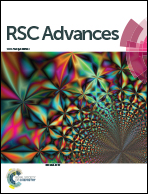Facile fabrication of core/shell structured SiO2/polypyrrole nanoparticles with surface modification and their electrorheology
Abstract
We synthesized conductive polypyrrole (PPy) coated silica core–shell structured nanoparticles, and investigated their electrorheological (ER) characteristics under electric fields applied when dispersed in silicone oil. Silica nanoparticle surfaces were initially modified using 3-(trimethoxysilyl)propyl methacrylate as a modifying agent to enhance the chemical affinity for more stable core–shell particle formation with PPy shells. Scanning electron microscopy and transmission electron microscopy images provided evidence of the structure and morphology of the fabricated particles. ER behavior of the obtained particles dispersed in an insulating silicone oil were observed via a controlled shear rate test using a rotational rheometer, while fibrillation of the ER fluid was observed using optical microscopy. The resulting responses show that the fluid composed of silica/PPy nanoparticles exhibits typical ER fluid behavior under an applied electric field. A CCJ model was used to explain the flow curves for overall shear rate range along with dielectric spectral measurements.


 Please wait while we load your content...
Please wait while we load your content...